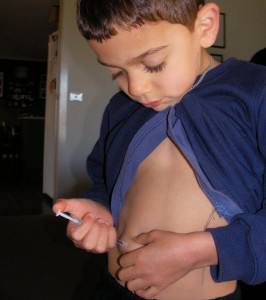Type 1 diabetes diagnosis: Tristan’s journey
Type 1 diabetes is an incurable condition which must be carefully managed to prevent complications. Like the more common type 2 diabetes, the condition is characterised by abnormal blood glucose levels. Unlike type 2 diabetes which can be prevented and treated through healthy eating and lifestyle, there is no known way to prevent type 1 diabetes.
Each day, two Australian children are newly diagnosed with the condition, making Australia one of the ten countries with the highest number of new diabetes cases. While a type 1 diabetes diagnosis means a lifetime of glucose monitoring and injections, it can be a life-saving diagnosis. Unless it is correctly diagnosed and treated, children living with type 1 diabetes are likely to experience complications.
Although more commonly diagnosed in older children, type 1 diabetes can occur at any age. We spoke to Suzie, whose mother’s intuition led to a diagnosis of type 1 diabetes when her son was just 23 months old.
Why is my son always hungry and thirsty?
Suzie knew something was wrong with her son Tristan when his behaviour and habits changed.
“He had really extreme mood swings. One minute he was full of life and then he was completely quiet or became irritated or ‘spaced out’, staring off into the distance. Other times he would just be tired and have no energy, constantly yawning. We put this all down to him being a toddler.”
Tristan was also constantly hungry and thirsty.
“Sometimes he would have three large meals and during the day he grazed a lot. At first we thought that this was due to ‘growth spurts’. But despite all the eating, he started losing weight. He was also drinking huge amounts of water, and peeing so much in the night that he would soak through his nappies and clothes.”
In type 1 diabetes the pancreas, which normally produces the hormone insulin to regulate blood sugar levels, stops working properly. The pancreatic cells that produce insulin are progressively destroyed, causing blood glucose levels to rise. Other body organs try to correct the blood glucose levels. For example, the kidneys produce urine more rapidly to remove excess glucose from the body, which causes more frequent urination and thirst. Because glucose in the blood cannot be used as a source of energy, the body starts to burn fat instead, which leads to weight loss.
“I had a mother’s intuition that something was not right with my son and googled three symptoms: constant hunger, bed wetting, and constant thirst. On my computer appeared all the info on type 1 diabetes.”
Getting tested for type 1 diabetes
“I made a doctor appointment for the next day,” Suzie said.
When she got there, she said to the doctor, “I think Tristan has type 1 diabetes, these are his symptoms.”
Suzie asked the doctor to do a blood test and got a referral for that.
“I had the blood test done the following morning. I didn’t want to believe that my child had diabetes. Like many people, I had only heard of type 2 diabetes and thought that being a young child, Tristan hadn’t eaten too many sweets and he was quite active, so how would it be possible for him to have diabetes?”
While she knew something was wrong and Tristan needed testing, Suzie found it difficult to watch her son have a blood test.
“I had to fight hard to keep my tears away as he screamed and cried. The nurse had difficulty getting blood out as Tristan was so dehydrated, so she had to try a few times in different spots. All the while Tristan was screaming and crying. At the time I felt really guilty putting him through that.”
However in hindsight Suzie is glad she did. Having a blood test is the only way to diagnose type 1 diabetes – although urine and finger prick tests can be used as an initial test for type 1 diabetes in a doctor’s consulting rooms, they are always followed by a blood test.
A type 1 diabetes diagnosis means a diabetes management plan can be instituted, improving the child’s health and reducing the chances of complications, which in exceptional circumstances can be life-threatening. In Tristan’s case the diagnosis meant his condition could be properly understood and emergency treatment to prevent complications instituted.
Take your son straight to the emergency department
Suzie received a call that night that Tristan’s blood tests were performed.
“It was the same day at about 11pm that I received a phone call from Melbourne Pathology, asking if we were Tristan’s parents. My heart started racing. I then knew it could be serious and had a sick feeling in my stomach.”
The caller asked Suzie to take Tristan to the emergency department immediately, as without treatment there was a possibility he would experience complications.

“I asked the caller if I could go in the morning. My youngest son was just six months old at the time. He was asleep and I didn’t want to wake him up,” Suzie said.
However, the caller recommended she go immediately to the hospital, even advising Suzie to bypass the closer hospitals and go straight to one where he could see a specialist.
“He said he would call the hospital and let them know we were coming.”
While the news was still sinking in Suzie packed overnight bags for her and Tristan. Scared and confused, she bundled her son into the car.
Emergency treatment, a hospital stay and Tristan’s home again
“When we arrived at the emergency department, Tristan was seen immediately and then admitted. We were moved to the paediatric ward the next day. The nurses were checking Tristan’s blood glucose levels every hour.”
Unfortunately Tristan was afraid of needles, so what might be a simple blood check in an adult, was quite an ordeal.
“He cried and pleaded for the nurses not to hurt him each time they wanted to check his blood.”
Suzie quickly learnt that despite looking healthy, Tristan’s diagnosis of type 1 diabetes meant that he would need blood glucose tests and insulin injections every day.
“My partner Geoff and I got a crash course on type 1 diabetes, were told the ins and outs on how to care for Tristan and that we would be met by a team of professionals – doctors, endocrinologists, diabetes educators and dietitians – who would all help us with caring for Tristan.
“We were shown how to draw up insulin in a syringe so that it could be injected into his stomach. My hand was shaking as I had never held a syringe before. I just couldn’t bring myself to inject Tristan. Geoff did the first few injections but I also had to inject Tristan before we were allowed to go home. We had to learn all sorts of other things like how to work the meter that tests his blood glucose level and what to do if they were too high or too low, how to feed him and care for him to prevent complications.
“We felt like our world had come crashing down. I don’t know how we survived those days when Tristan was diagnosed. We also had a six month old baby. Even before the diagnosis it felt like we weren’t getting enough sleep.”
Advice to other parents
Suzie said her experience has made her aware of just how many young children live with undiagnosed type 1 diabetes.
“Since Tristan was diagnosed, I’ve heard many stories similar to mine. If the symptoms of type 1 diabetes are not picked up early enough it can be dangerous. However, once you know your child has it, the condition can be managed.”
Suzie is trying to raise awareness about the condition in the hope that other children get diagnosed. Suzie encourages other parents to trust their intuition and go see a doctor immediately if their child has symptoms of type 1 diabetes.
References
- Incidence of type 1 diabetes in Australian children 2000-2008 [online]. Australian Institute of Health and Social Welfare; 2010 [cited 9 February 2014]. Available from: [URL link]
- Diabetes in Australia [online]. Diabetes Australia; 2013 [cited 9 February 2014]. Available from: [URL link]
- How is diabetes diagnosed? [online]. Diabetes Victoria; 2013 [cited 15 February 2014]. Available from: [URL link]
Dates
Tags
Created by:

 Login
Login














